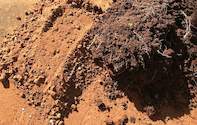
It's easy to forget about soil. You have to look down on the ground to see it. Even then, soil may not seem to do very much. But there's more to soil than you might think. It isn't just dirt that gets on your shoes. Trees and plants need soil to grow. Very few fruits, vegetables and grains would live without it. Many animals need soil, too. They eat the plants that grow in it. Some animals even live in the soil. Can you imagine a world without soil?
Most soil comes from rocks. Over many years, weather causes rocks to break apart. The pieces get smaller and smaller as time goes on. Soil forms when bits of rock mix with things like dead leaves and dead bugs. Not all soil is the same. Soil comes in many colours. Some soil looks and feels different than other soil. The colour and feel of soil often changes as you dig deeper into the ground.
You can learn a lot by seeing and touching soil. In a way, soil is like a secret decoder. Water also affects the colour of soil. Wet soil is usually darker than dry soil. The feel of soil can tell you about its ingredients. Soil contains different amounts of sand, silt and clay. Soil in a forest might be gritty, which means more sand.
Soil in a meadow might be smooth, which means more silt. Soil in a garden might be sticky, which means more clay.Did you know that squeezing soil can tell you about the weather? If soil crumbles between your fingers, then the weather has probably been dry. If soil is wet and sticky - yuck! - then it might have rained not too long ago.
Soil that is wet and sticky is called mud. Some people don't like to get mud on them. But if someone offers you mud pie, you might first want to find out how it was made. Some mud pies are made by playing with water and soil. But the dessert called mud pie is actually made of chocolate! Yum!

